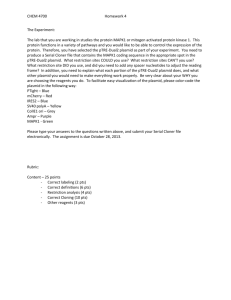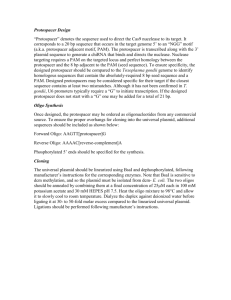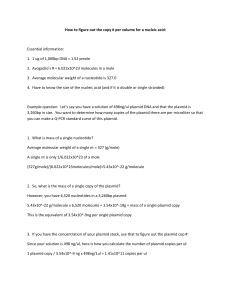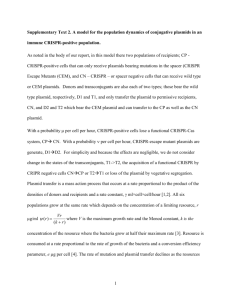Lab: Let There Be Light! Bacteria Transformation Introduction. In this
advertisement
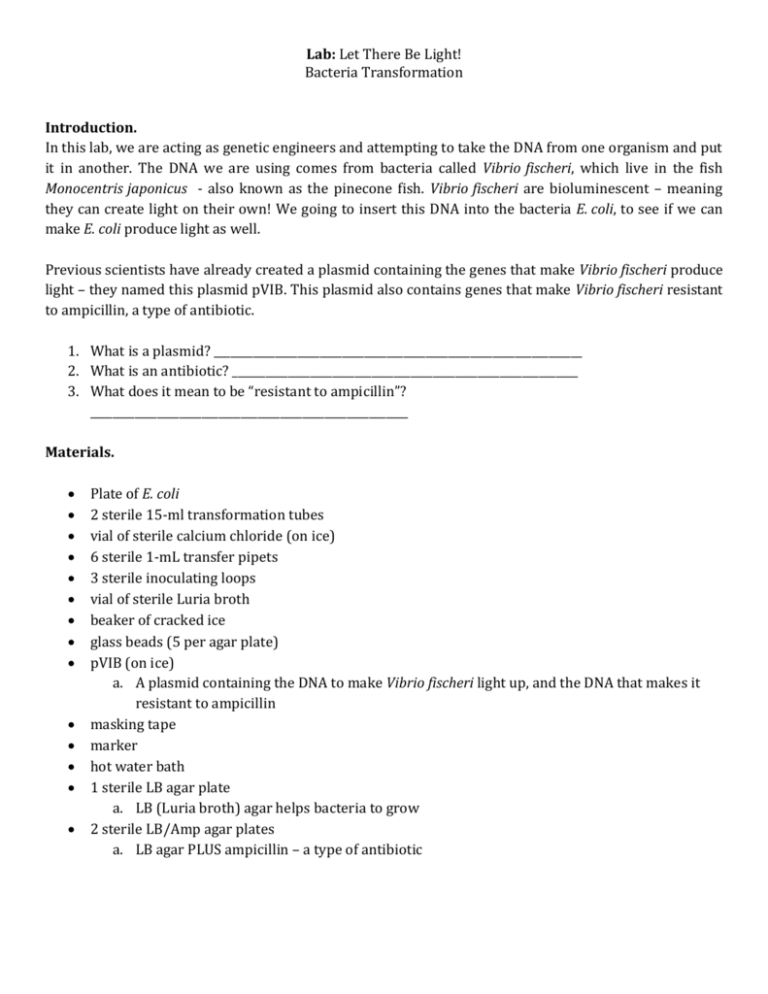
Lab: Let There Be Light! Bacteria Transformation Introduction. In this lab, we are acting as genetic engineers and attempting to take the DNA from one organism and put it in another. The DNA we are using comes from bacteria called Vibrio fischeri, which live in the fish Monocentris japonicus - also known as the pinecone fish. Vibrio fischeri are bioluminescent – meaning they can create light on their own! We going to insert this DNA into the bacteria E. coli, to see if we can make E. coli produce light as well. Previous scientists have already created a plasmid containing the genes that make Vibrio fischeri produce light – they named this plasmid pVIB. This plasmid also contains genes that make Vibrio fischeri resistant to ampicillin, a type of antibiotic. 1. What is a plasmid? __________________________________________________________________ 2. What is an antibiotic? ______________________________________________________________ 3. What does it mean to be “resistant to ampicillin”? _________________________________________________________ Materials. Plate of E. coli 2 sterile 15-ml transformation tubes vial of sterile calcium chloride (on ice) 6 sterile 1-mL transfer pipets 3 sterile inoculating loops vial of sterile Luria broth beaker of cracked ice glass beads (5 per agar plate) pVIB (on ice) a. A plasmid containing the DNA to make Vibrio fischeri light up, and the DNA that makes it resistant to ampicillin masking tape marker hot water bath 1 sterile LB agar plate a. LB (Luria broth) agar helps bacteria to grow 2 sterile LB/Amp agar plates a. LB agar PLUS ampicillin – a type of antibiotic Procedure. 1. Take one of your sterile 15-mL tubes and label it “+ plasmid”. This means we will add pVIB to this tube. 2. Take your other sterile 15-mL tube and label it “-plasmid”. This means we will not add pVIB to this tube. 3. Use one of your pipets to add 250 μL of calcium chloride to each tube. 4. Place both tubes on ice. 5. Use one of your inoculating loops to transfer single colonies of E. coli from the starter plate to the + plasmid tube. The total amount of bacteria added should be no more than the size of the top of a pencil eraser. a. Do not add any of the agar from the plate along with the cell mass. b. Immerse the cells on the loop in the calcium chloride solution in the + plasmid tube and spin the loop quickly in the solution to dislodge the cell mass. Hold the tube to the light to make sure that the cell mass has fallen off the loop. 6. Immediately suspend the cells by repeatedly pipetting in and out with a new pipet. Hold the tube to the light to make sure no clumps of cells are in the tube or in the pipet. The cells should look milky white in the solution 7. Return the + plasmid tube to ice. 8. Repeat the steps 5 to 6 with the – plasmid tube. 9. Return the – plasmid tube to ice. 10. Use a new inoculating loop to add a loopful of pVIB to the + plasmid tube. a. Immerse the loopful directly into the bacteria cells. Spin the loop to mix the DNA wih the cells. 11. Return the +plasmid tube to ice. Leave them there for 15 minutes. 12. While you are waiting for the 15 minutes to be up, label your plates as follows with your lab group members’ initials and the date. a. One LB/Amp plate should be labeled “+ plasmid” b. The other LB/Amp plate should be labeled “- plasmid c. Label your LB plate either “+ plasmid” or “- plasmid” according to your teacher. 13. After the 15 minutes are up, remove both tubes from the ice and IMMEDIATELY immerse them in the hot water bath for 90 seconds. Gently move the tubes while they are immersed. 14. Use a new pipet to add 250 μL Luria broth to each tube. Tap the tubes to mix the LB with the suspended cells. Wait for 5 to 15 minutes. 15. Use a new pipet to add 100 μL of cells from the – plasmid tube onto each – plasmid plate. 16. Slightly open the lids and carefully pour 4-6 glass beads onto each plate. 17. Use a back-and-forth shaking motion to move the glass beads across the entire surface of the plates. 18. Let the plates rest for several minutes. 19. Hold each plate vertically over a container, slightly open the lower part of the plate, and tap out the glass beats into the container. 20. Repeat steps 15-19 for the + plasmid tube and + plasmid plates. 21. Wrap the plates together with tape and place the plates upside down. Incubate the plates at room temperature for 36 – 60 hours. Data and Analysis 1. Predict your results in the table below. Write “yes” or “no” depending on whether you think the plate will show bacteria growth. Write the reasons for your predictions. 2. Record yours results on the table below. Plate Prediction Reasoning Observed Number of (will there be Result colonies growth?) (was there (if there are too growth?) many to count, put “lawn”) LB - plasmid LB + plasmid LB/amp plasmid LB/amp + plasmid 3. Did your predictions match your observations? Explain why there may have been a difference between your predictions and observations if there were any. 4. How would you improve this experiment if you were to repeat it? Discuss a minimum of two sources of error and what you would do to minimize them. 5. Did your results differ from those of your classmates? Why is it valuable to be able to analyze the entire class’ data instead of just your own?



